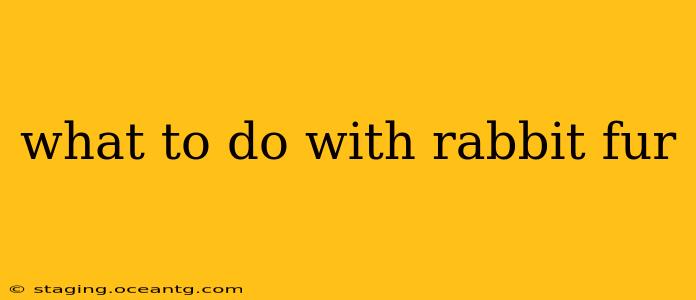Rabbit fur, once a byproduct of meat production or obtained ethically from breeders, presents several options for its use. Depending on the quantity and condition of the fur, you can choose from a range of creative and practical applications. This guide explores various possibilities, considering both traditional methods and modern, sustainable approaches.
Can I Use Rabbit Fur for Clothing?
Yes, rabbit fur has long been prized for its softness and warmth, making it suitable for clothing. However, the ethical sourcing of the fur is crucial. If you have ethically sourced rabbit fur, you can use it to create a variety of garments or accessories. This might involve:
- Felting: Rabbit fur is excellent for felting, a process that creates strong, durable fabrics without weaving or knitting. Felted rabbit fur can be used to make hats, scarves, gloves, or even small decorative items.
- Sewing/Crafting: With careful preparation, rabbit fur can be sewn into garments or incorporated into existing designs. This could include lining a coat, creating patches, or adding decorative elements to clothing. However, it requires specific sewing techniques due to the delicate nature of the fur.
- Fur Trimming: Rabbit fur can be used as a trim for existing garments, adding a touch of luxury and warmth to collars, cuffs, or hems.
What Can I Make with Rabbit Fur Scraps?
Even smaller pieces of rabbit fur can be repurposed creatively:
- Felted Ornaments: Small scraps are perfect for creating felted ornaments for the holidays or other special occasions.
- Patches: Create decorative patches to repair or personalize clothing.
- Stuffed Toys: Rabbit fur can provide a soft and luxurious filling for handmade stuffed toys.
Is Rabbit Fur Good for Insulation?
While not as widely used as other materials, rabbit fur possesses insulating properties. Its soft, fluffy nature traps air, providing warmth. However, it's crucial to consider its durability and the potential for pest infestation. You might consider using it for:
- Insulating Garments: As a lining or interfacing in garments intended for cold weather.
- Crafting Projects: For insulation in small-scale crafts like mittens or doll clothes.
How Do I Clean Rabbit Fur?
Cleaning rabbit fur requires a delicate approach to avoid damaging the fibers. Avoid harsh detergents and machine washing. Gentle hand washing with a mild soap and cool water is recommended, followed by careful air drying away from direct sunlight or heat. Professional cleaning services specializing in fur are another option.
Where Can I Sell Rabbit Fur?
Selling rabbit fur might depend on its quantity and quality, as well as the legality and ethics around the fur's origin in your area. Options may include:
- Online Marketplaces: Sites specializing in handcrafted goods or vintage materials might be suitable platforms.
- Craft Fairs and Markets: These events can provide a direct route to potential buyers interested in handmade items.
- Local Furriers: Although less common, some furriers may accept rabbit fur.
Is Rabbit Fur Eco-Friendly?
The eco-friendliness of rabbit fur depends heavily on its source. Ethically sourced fur, from rabbits raised for meat and whose fur is a byproduct, has a lower environmental impact than fur from animals raised solely for their pelts. However, it's still important to consider the potential for waste and the overall environmental impact of the production process.
What are the Ethical Considerations of Using Rabbit Fur?
Ethical sourcing is paramount. Prioritize fur obtained as a byproduct of meat production or from ethical breeders who prioritize animal welfare. Avoid fur from animals raised in factory farms or those subjected to inhumane treatment.
This guide provides a starting point for exploring the potential uses of rabbit fur. Remember to always prioritize ethical sourcing and responsible handling of the material. By using sustainable and ethical practices, you can transform rabbit fur into unique and beautiful creations.
